|
|
おとめ座銀河団は,距離が6000万光年で,銀河系から最も近い銀河団です.
中心の巨大楕円銀河M87をはじめとして,100以上の大きな銀河を持ち,
おそらくトータルでは1000個程度の銀河をもっていると考えられています. 最も近い距離にある銀河団であるため, 細かい構造までをクローズアップして観測するのに絶好のターゲットです. あすか では,おとめ座銀河団のマッピング観測を行い, 銀河団に付随する高温ガスの温度構造を明らかにする研究を行いました. これまでに,およそ50万秒,のべ約10平方度の領域の観測を行ってきました. マッピング観測の観測点を左に示しました. ローサット全天サーベイで得られた画像に, あすか のGIS検出器の視野に相当する円で観測点を示しています. 青がこれまでに観測,解析された点であり, 赤が1999年に観測する(予定)点を示しています. また,緑の点はローサット全天サーベイでのX線源を表しています. |
|
The Virgo Cluster is in the distance of 60 million light years.
It is the nearest cluster from our galaxy.
It has the 100 or more big galaxies including the central huge elliptical galaxy M87,
and if total probably, it is thought that it has about 1000 galaxies.
Since it is a cluster in the nearest distance, it is a target best for observing even fine structure in detail. In ASCA, mapping observation of the Virgo Cluster was performed to research that clarifies temperature structure of the high temperature gas which accompanies a cluster was done. The top is the observing point of mapping observation. A circle is a observed point by ASCA (GIS) and it is equivalent to the view of ASCA. The blue circle is observed and just going to be analyzed until now. The red circle shows the planning point to be observed in 1999. Moreover, a green point is expressed the whole sky by ROSAT. By courtesy of K.Kikuchi / NASDA, T.Ohashi / Tokyo Metropolitan Univ. | |
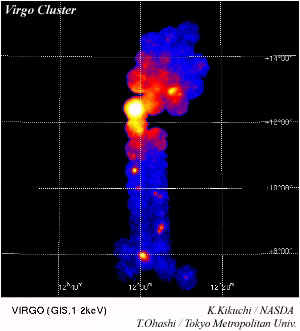 |
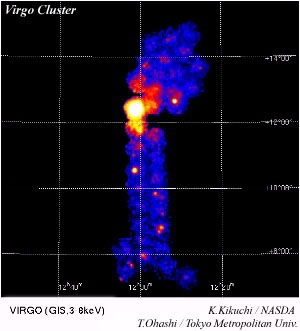 |
|
A top is as a result of observation.
The left is the X-ray image in low energy band of 1-2 keV and
the right is in the high energy band of 3-8 keV.
The result of analysis, there is a high temperature region (about 4.4 keV(s)) between M87 and M49.
これまでの観測によって得られた画像が上の図です. それぞれ 1-2 keV の低エネルギーバンド, 3-8 keV の高エネルギーバンドでの画像です. 解析の結果,M87とM49との中間には温度が約4.4keVと, 周囲 (約2keV)と比べて有意に温度が高い領域が存在することがわかってきました. By courtesy of K.Kikuchi / NASDA, T.Ohashi / Tokyo Metropolitan Univ. | |
The X-ray Spectrum of Virgo Cluster
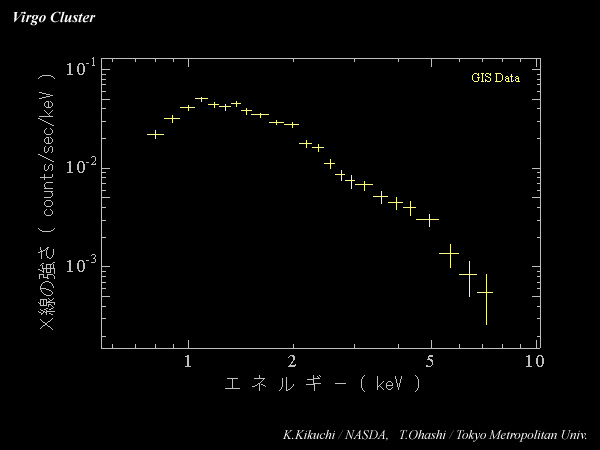 |
|
It is the X-ray spectrum observed by ASCA (GIS).
A top is the spectrum of the high-temperature region (the southern observing point of 5, 7, and 9 was added) .
And the bottom is the spectrum of a low-temperature region (the southern observing point of 6, 8, and 10 was added).
If two are compared, it turns out that inclination of a spectrum is different.
上図は温度の高い領域,南部の5,7,9の観測点を足し合わせたスペクトルで, また,下図が低温領域,南部の6,8,10の観測点を足し合わせたスペクトルです. 比べるとスペクトルの傾きが違っているのがわかると思います. 一方,ローサットの観測から, M49は1300km/s程度の速度でおとめ座銀河団の方向に落ち込んでいるとの報告がなされています. あすか で得られたスペクトルの情報からでは, この領域からのX線放射が熱的なものか非熱的なものかを区別することができませんが, 放射の起源が熱的,非熱的のいずれであるにしても, M49小集団の衝突に伴う加熱または加速が生じている可能性が高いと考えらます. (ともに あすか のGIS検出器で得られたスペクトルです) By courtesy of K.Kikuchi / NASDA, T.Ohashi / Tokyo Metropolitan Univ. |
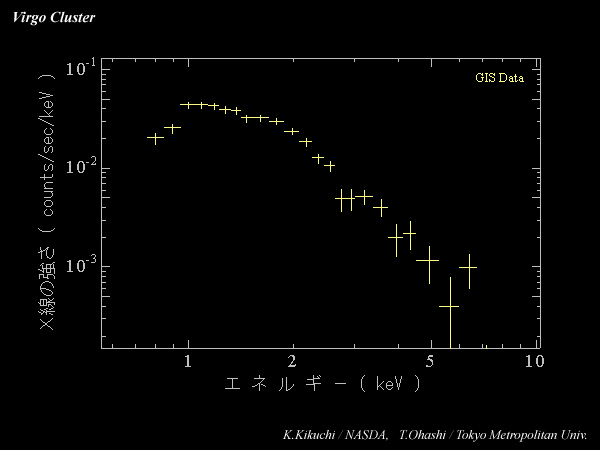 |
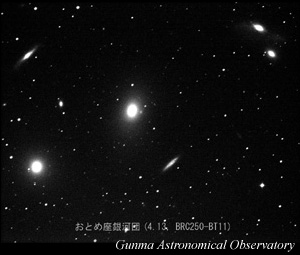
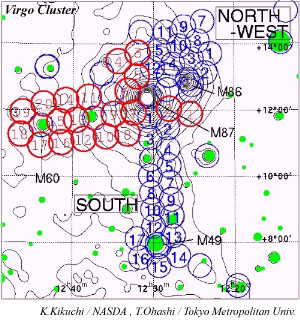
 Go to Submenu
Go to Submenu Go to Menu
Go to Menu